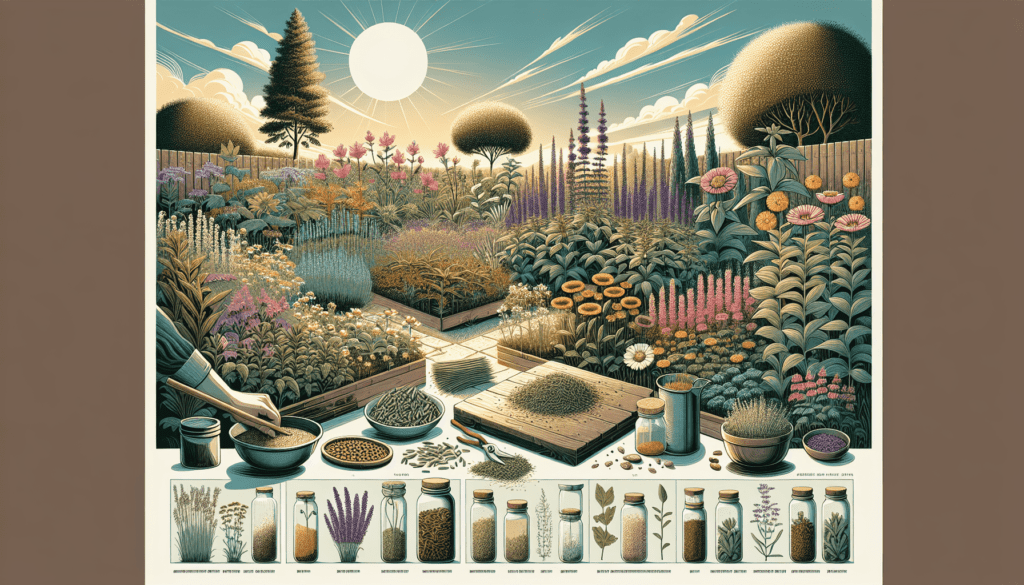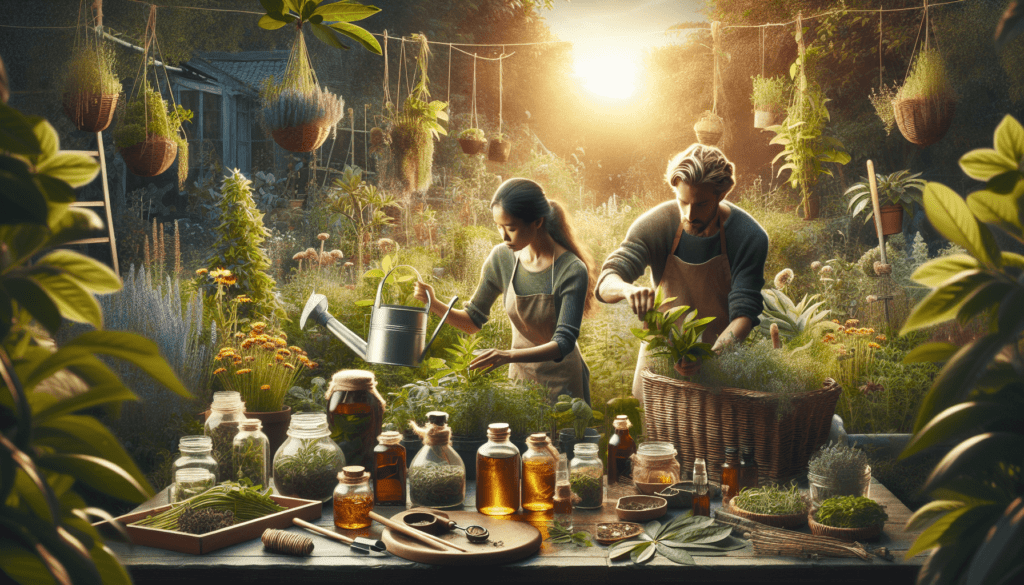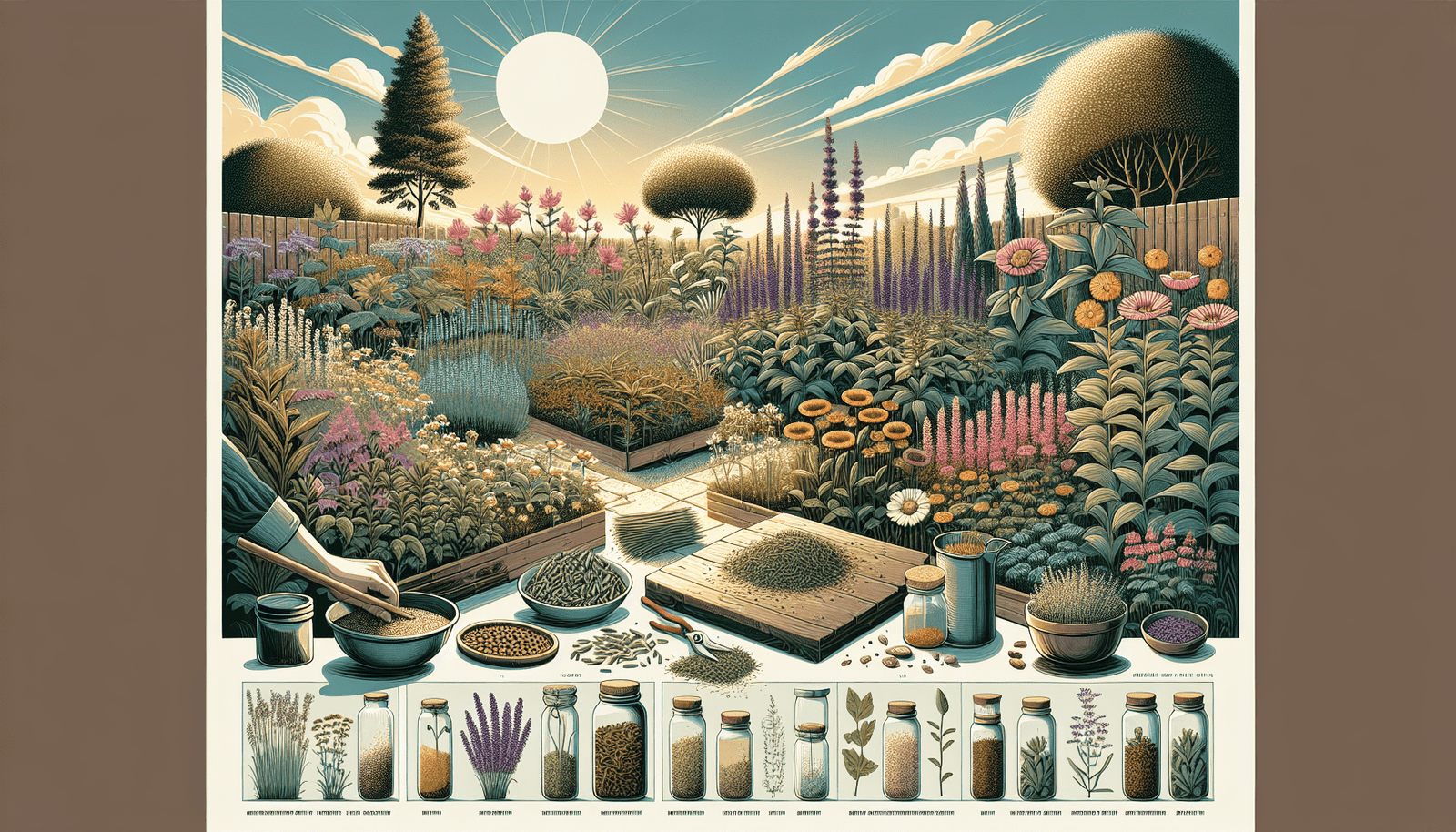In this friendly guide, you will discover the fascinating world of growing and using medicinal plants. From lavender’s calming properties to aloe vera’s healing benefits, this article will serve as your go-to resource for all things herbal. As you explore the step-by-step process of planting and nurturing these natural remedies, you’ll gain valuable insight into the various ways to maximize their potential and harness their healing powers. Get ready to immerse yourself in the art of cultivating and utilizing medicinal plants like never before.

Introduction to Medicinal Plants
What are medicinal plants?
Medicinal plants are plants that have been used for centuries for their therapeutic properties and are specifically grown and cultivated for medicinal purposes. These plants contain substances that can be used to treat various ailments and medical conditions. They can be used in various forms such as teas, extracts, tinctures, salves, or creams.
Why grow medicinal plants?
Growing medicinal plants can offer numerous benefits. Firstly, it allows you to have easy access to natural remedies for common ailments right at your fingertips. It can also be a cost-effective solution as you can avoid purchasing expensive commercial medicines. Additionally, cultivating medicinal plants in your garden can contribute to a more sustainable and eco-friendly lifestyle as you reduce your reliance on conventional medical products.
Benefits of using medicinal plants
There are several advantages to using medicinal plants. Firstly, they often have fewer side effects compared to synthetic drugs, making them a safer alternative for many individuals. Medicinal plants can also provide a more holistic approach to healing, as they can address not only the symptoms but also the underlying causes of a particular condition. Moreover, growing and using medicinal plants can help reconnect individuals with nature and promote a sense of well-being.
Choosing the Right Medicinal Plants
Understanding your needs
Before selecting medicinal plants to grow, it is important to understand your specific needs and health goals. Consider the health conditions you or your family members commonly experience and the symptoms you would like to address. Research different medicinal plants that are known to be effective for those conditions.
Researching the different plants
Take the time to research each medicinal plant you are considering. Learn about their medicinal properties, the parts of the plant that are used, and any potential side effects or interactions with medications you may be taking. Look for reputable sources such as scientific journals or books written by experts in the field of herbal medicine.
Considering growing requirements
Each medicinal plant has specific growing requirements that need to be considered. Some plants thrive in direct sunlight, while others prefer partial shade. Some require well-draining soil, while others thrive in moist conditions. Take into account the available space in your garden or the type of containers you will be using, as well as the climate of your region.
Preparing Your Growing Space
Indoor vs. outdoor cultivation
Decide whether you will be growing your medicinal plants indoors or outdoors. Indoor cultivation allows for greater control over environmental conditions such as temperature and humidity, while outdoor cultivation allows plants to benefit from natural sunlight and fresh air. Consider factors such as available space, lighting options, and the specific requirements of the medicinal plants you have chosen.
Selecting a suitable location
If you choose to grow your medicinal plants outdoors, select a suitable location in your garden that receives adequate sunlight and has well-draining soil. Ensure that the area is free from chemicals or pollutants that could potentially impact the quality of the plants. If you opt for indoor cultivation, choose a space near a window that receives ample sunlight or invest in artificial grow lights.
Preparing the soil or containers
Prepare the soil in your garden by removing any weeds or debris and loosening it with a garden fork or tiller. Amend the soil with organic matter such as compost or well-rotted manure to improve its fertility and drainage. If you are growing your plants in containers, ensure they are clean and have sufficient drainage holes. Fill them with a well-balanced potting mix suitable for the specific plants you are growing.
Starting from Seeds or Seedlings
Collecting seeds or purchasing seedlings
Decide whether you want to start your medicinal plants from seeds or purchase seedlings from a reputable nursery. Collecting seeds from mature plants can be cost-effective, but it may take longer for the plants to reach maturity. Purchasing seedlings provides a head start and may be a more convenient option for beginners.
Germinating seeds successfully
If you choose to start your plants from seeds, follow the specific germination requirements of each plant. Some seeds may need to be soaked or scarified before planting, while others may require stratification or the application of heat. Ensure that the seeds are sown at the appropriate depth and provide consistent moisture and warmth for successful germination.
Transplanting seedlings
When the seedlings have grown several sets of leaves and are sturdy enough, they can be transplanted into the garden or larger containers. Harden off the seedlings by gradually exposing them to outdoor conditions before transplanting to minimize transplant shock. Dig a hole slightly larger than the root ball, place the seedling in the hole, and gently backfill with soil, ensuring that the plant is at the same depth as it was in its original container.

Caring for Medicinal Plants
Providing proper sunlight and water
Most medicinal plants require a minimum of six to eight hours of direct sunlight per day to thrive. Ensure that your plants are placed in a location that provides adequate sunlight. Water your plants regularly, keeping the soil moist but not waterlogged. Monitor the moisture level by checking the soil with your finger or using a moisture meter. Adjust watering frequency based on the specific needs of each plant.
Fertilizing and amending the soil
To promote healthy growth, periodic fertilization may be necessary. Use organic fertilizers such as compost or diluted liquid seaweed to provide essential nutrients to your medicinal plants. Additionally, you can amend the soil with compost or organic matter to enhance its fertility and improve its ability to retain moisture and nutrients.
Pest and disease management
Monitor your plants regularly for signs of pests or diseases. Common pests that may affect medicinal plants include aphids, spider mites, and whiteflies. Use organic methods such as insecticidal soaps or neem oil to control pests. Avoid using synthetic pesticides, as they can have negative effects on the beneficial organisms that support the health of your plants. Proper sanitation practices, such as removing affected leaves or plants, can help prevent the spread of diseases.
Harvesting and Storing Medicinal Plants
Identifying the right time for harvest
Each medicinal plant has a specific time for optimal harvest, depending on the part of the plant used. Research and identify the appropriate time to harvest your plants to ensure that they contain the highest concentration of medicinal compounds. Generally, harvesting is done when the plant is in full bloom but before it starts to decline.
Proper techniques for harvesting
Use clean and sharp gardening shears or scissors to harvest your plants. Cut the plant stems above a set of healthy leaves or nodes to encourage new growth. For plants with leaves or flowers used medicinally, carefully remove the desired parts without damaging the rest of the plant. Be mindful of the plant’s natural growth patterns and avoid overharvesting, as this can weaken the plant and reduce its future productivity.
Drying and storing medicinal herbs
To preserve the potency of the medicinal compounds, it is important to properly dry and store the harvested plant material. Hang the herbs upside down in a well-ventilated, dry room away from direct sunlight. Once fully dried, remove the leaves or flowers from the stems and store them in airtight containers in a cool, dark place. Label each container with the name of the herb and the date of harvest to ensure freshness and easy identification.
Common Medicinal Plants and Their Uses
Aloe vera for topical ailments
Aloe vera is a well-known medicinal plant that has been used for centuries to soothe and heal various skin conditions. The gel found inside the leaves of the aloe vera plant can be applied topically to treat minor burns, cuts, sunburns, and skin irritations. It has cooling and anti-inflammatory properties, making it an effective natural remedy for skin ailments.
Chamomile for relaxation and sleep
Chamomile is a popular medicinal plant known for its calming and sedative effects. The flowers of the chamomile plant can be used to make a soothing tea that promotes relaxation and helps with sleep disorders, anxiety, and digestive issues. Chamomile tea is often consumed before bedtime to aid in winding down and improving sleep quality.
Echinacea for immune support
Echinacea is a medicinal plant commonly used to boost the immune system and fight off colds and flu. Its roots, leaves, and flowers contain compounds that stimulate the production of white blood cells, which are essential for combating infections. Echinacea supplements or teas are often consumed at the onset of cold or flu symptoms to support the body’s natural defense mechanisms.
Lavender for stress relief
Lavender is a fragrant medicinal plant that is widely known for its calming properties. The essential oil extracted from lavender flowers can be used to alleviate stress, anxiety, and insomnia. It can be diffused, applied topically, or added to bathwater for a relaxing and soothing experience. Lavender is also used in aromatherapy to promote relaxation and a sense of well-being.
Peppermint for digestive issues
Peppermint is a medicinal herb with a refreshing scent and a variety of medicinal uses, particularly for digestive issues. Drinking peppermint tea or using peppermint oil can help relieve symptoms such as indigestion, bloating, and nausea. Peppermint is known for its ability to relax the muscles of the gastrointestinal tract and alleviate discomfort associated with digestive disorders.
Preparing Medicinal Remedies
Creating herbal teas and infusions
One of the most common ways to use medicinal plants is by preparing herbal teas or infusions. To create a herbal tea, steep the desired medicinal plant parts, such as leaves, flowers, or roots, in hot water for a specific duration. Strain the tea and enjoy it warm or chilled. Herbal infusions are similar but involve a longer steeping time to extract more potent compounds.
Making herbal tinctures and extracts
Herbal tinctures and extracts are concentrated forms of medicinal plants that are extracted using alcohol or glycerin. They are often used for their convenience and long shelf life. To make a tincture, macerate the desired plant parts in alcohol or glycerin for several weeks, shaking the mixture occasionally. Strain out the plant material and store the tincture in dark glass bottles.
Crafting salves and creams
Salves and creams are topical applications that can be made using medicinal plants for various purposes, such as soothing skin irritations or promoting healing. To create a salve or cream, melt natural beeswax and combine it with infused herbal oils. Once cooled and solidified, the salve or cream can be applied to the affected area as needed.
Understanding Dosages and Safety
Consulting with a healthcare professional
When using medicinal plants for therapeutic purposes, it is important to consult with a healthcare professional, especially if you have underlying health conditions or are taking medications. They can provide guidance on appropriate dosages, potential interactions with existing medications, and any contraindications or precautions you should be aware of.
Determining appropriate dosages
Dosages of medicinal plants can vary depending on the specific plant, the part used, and the intended use. It is crucial to follow recommended dosages provided by reputable sources or healthcare professionals. Start with lower doses and gradually increase if necessary while monitoring for any adverse effects.
Identifying potential side effects or interactions
While medicinal plants are generally considered safe, it is important to be aware of potential side effects or interactions. Some individuals may be allergic to specific plants or may experience digestive issues or skin irritation. Certain plants may also interact with medications, altering their effectiveness or causing adverse reactions. Always research and consult with a healthcare professional to ensure safe and effective use.
Exploring Additional Resources
Books and guides on herbal medicine
There are numerous books and guides available on herbal medicine that provide in-depth information on growing, using, and preparing medicinal plants. Look for reputable authors and publications that are backed by scientific research and have positive reviews from readers. Some recommended books include “The Herbal Medicine-Maker’s Handbook” by James Green and “Rosemary Gladstar’s Medicinal Herbs: A Beginner’s Guide” by Rosemary Gladstar.
Online communities and forums
Engaging with online communities and forums dedicated to herbal medicine can be a valuable resource for sharing knowledge, asking questions, and connecting with individuals who have similar interests. Platforms such as Reddit, Facebook groups, or specialized forums like HerbMentor provide opportunities to learn from experienced practitioners and enthusiasts.
Local workshops and classes
If you prefer hands-on learning, consider attending local workshops or classes on growing and using medicinal plants. Many botanical gardens, nurseries, or community centers offer courses on herbal medicine, where you can learn essential skills, interact with experts, and gain practical experience. Check local event listings or websites for upcoming workshops in your area.
By following this comprehensive guide, you can start your journey into growing and using medicinal plants. Remember to always do thorough research, consult with healthcare professionals, and prioritize your safety and well-being. Cultivating and utilizing medicinal plants can not only provide natural remedies but also deepen your connection with nature and enhance your overall health and wellness. Happy gardening and healing with medicinal plants!

